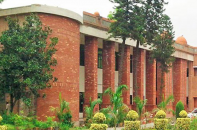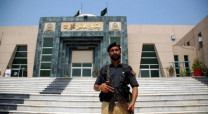World Haemophilia Day: For want of facilities, many cases go unreported
Health experts stress the need for awareness about the disorder.

There is a dearth of treatment facilities for haemophilia patients in public hospitals, said health experts here on World Haemophilia Day (Tuesday).
In the government sector, there is only one haemophilia centre based in Pakistan Institute of Medical Sciences (Pims) in the capital. The treatment being expensive, remains inaccessible especially to low income groups.
Haemophilia is a genetic bleeding disorder, in which the blood takes a long time to clot. It is caused when clotting factors VIII or IX are missing, which results in high chances of bleeding. Since the disorder occurs in X chromosome, the chance that women will have two defective chromosomes are minimal. So they generally serve as carriers and pass them on to male childs.
Pims Haemophilia Centre Senior Medical Officer Dr Tazeen Anwar said that patients are primarily treated by injecting factor VIII, if not available then by transfusing plasma. “The injection is not available here and patients are asked to get it from outside. One injection costs over Rs10,000 and patients can require more than one doze depending on the severity of the bleeding,” she added.
She explained that previously, patients received financial assistance from Baitul Mal, but that has not been the case for the past five months due to financial constraints. Plasma is also not available around the clock in the hospital. She said currently there are 560 cases of haemophilia registered with Pims and it is estimated that every year about 400 new cases of this disease emerge in the country but remain unreported.
Pakistan Haemophilia Society Rawalpindi-Islamabad Chapter President Dr Tahira Zafar, said currently there are 4,000 registered haemophilia patients in Pakistan. She said in Pakistan only factor VIII injections are available. However, there is a need to have injections of other factors such as VII, IX, XII among others.
The society through international organisations has arranged these missing injections for patients in case of an emergency. She said repeated plasma infusions can make the patient vulnerable to hepatitis C, as many of the process of blood transfusion or screening is not safe in most blood banks.
While sharing the symptoms, she said when a baby is born with haemophilia, there are blue bruises on his body, bleeding from nose, gums, there is an excessive bleeding when umbilical cord is cut and in males when circumcision is done.
Health Awareness Society Director Dr Samia Baber stressed a need to create awareness about this disease among general public. Whenever there is an excessive bleeding on minor cuts, one should consult the doctor and check for haemophilia. Dentists and surgeons should also be informed about the disease.
A family having history of this disease should avoid inter-family marriages. “There is a need to educate people on haemophilia, as it does not spread by shaking hands, secretions, touching or having food with a patient,” she said.
Published in The Express Tribune, April 18th, 2012.



















COMMENTS
Comments are moderated and generally will be posted if they are on-topic and not abusive.
For more information, please see our Comments FAQ